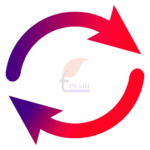NCERT Solutions for Class 7 Science Curiosity Chapter 3 Electricity: Circuits and their Components updated for Session 2025-26. It provides clear and accurate answers to all the textbook questions, helping students understand key concepts like electric circuits, cells, lamps, switches, conductors and insulators. NCERT Textbook solutions are designed as per the latest syllabus and encourage hands-on learning through activities and diagrams. They simplify complex ideas, making them easier for students to grasp and apply in everyday situations or science projects.
Class 7 Science Solutions
Class 7 Science Curiosity Chapter 3 Solutions
Let Us Enhance Our Learning
1. Choose the incorrect statement.
(i) A switch is the source of electric current in a circuit.
(ii) A switch helps to complete or break the circuit.
(iii) A switch helps us to use electricity as per our requirement.
(iv) When the switch is in ‘OFF’ position, there is an air gap between its terminals.
See Answer(i) A switch is the source of electric current in a circuit. (The electric cell or battery is the source of current.)
2. Observe Fig. 3.16. With which material connected between the ends A and B, the lamp will not glow?
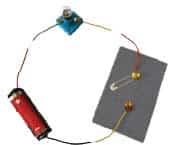
See AnswerThe lamp will not glow if an electrical insulator is connected between A and B. Examples include materials like plastic, rubber, wood, glass, paper or cork.
3. In Fig. 3.17, if the filament of one of the lamps is broken, will the other glow? Justify your answer.

See AnswerNo, the other lamp will not glow.
Justification: The lamps appear connected in series. A broken filament in one lamp creates a break in the single path, stopping the flow of electric current throughout the entire circuit. Therefore, the other lamp will also not receive current and will not glow.
4. A student forgot to remove the insulator covering from the connecting wires while making a circuit. If the lamp and the cell are working properly, will the lamp glow?
See AnswerNo, the lamp will not glow. The insulator covering prevents the metal wire inside from making electrical contact with the terminals. Without proper metal-to-metal contact, the electrical circuit is incomplete, and current cannot flow.
5. Draw a circuit diagram for a simple torch using symbols for electric components.
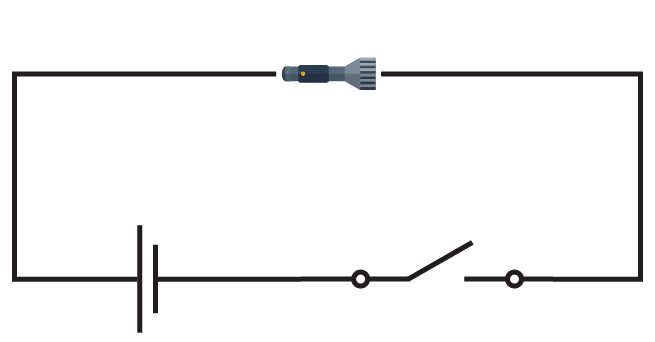
See AnswerA circuit diagram for a simple torch would show the following symbols connected in a loop (series): The symbol for a battery (two or more cells connected +/-), connected to the symbol for a switch (either in ON or OFF position), connected to the symbol for an electric lamp, connected back to the other terminal of the battery symbol.
6. In Fig. 3.18:
(i) If S₂ is in ‘ON’ position, S₁ is in ‘OFF’ position, which lamp(s) will glow?
(ii) If S₂ is in ‘OFF’ position, S₁ is in ‘ON’ position, which lamp(s) will glow?
(iii) If S₁ and S₂ both are in ‘ON’ position, which lamp(s) will glow?
(iv) If both S₁ and S₂ are in ‘OFF’ position, which lamp(s) will glow?
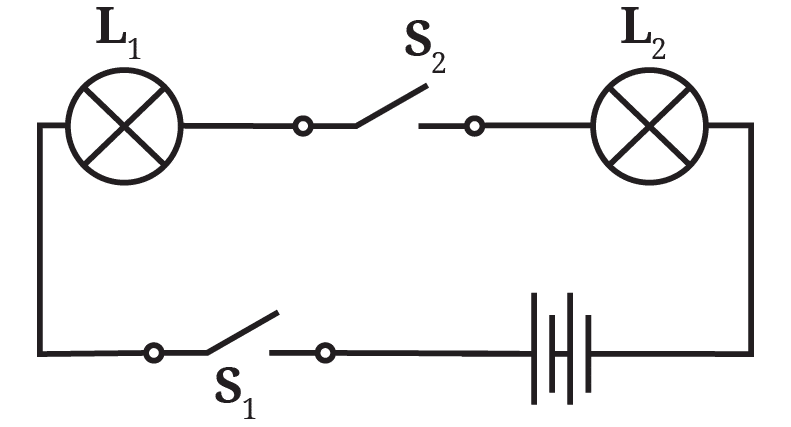
See Answer(Based on interpretation where S₁ is the main switch):
(i) None. (S₁ is OFF, breaking the main circuit).
(ii) L₁ only. (S₁ is ON, completing the circuit for L₁. S₂ is OFF, breaking the circuit for L₂).
(iii) L₁ and L₂. (S₁ is ON, allowing current. S₂ is ON, completing the circuit for L₂).
(iv) None. (S₁ is OFF, breaking the main circuit).
7. Vidyut has made the circuit as shown in Fig. 3.19. Even after closing the circuit, the lamp does not glow. What can be the possible reasons? List as many possible reasons as you can for this faulty operation. What will you do to find out why the lamp did not glow?
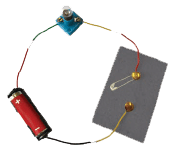
See AnswerPossible Reasons: The lamp’s filament is broken (lamp is ‘fused’); The electric cell is used up (dead) or faulty; Connections between wires and components (cell, switch, lamp) are loose or not making proper contact; A connecting wire might be broken internally; The switch might be faulty and not closing the circuit internally even when operated; The cell might be inserted incorrectly if a holder is used (reversed polarity); Insulation might not have been properly removed from the ends of the connecting wires.
Troubleshooting Steps: Systematically check each part: test the cell, test the lamp, check all connections to ensure they are tight and making metal-to-metal contact, visually inspect wires, test the switch (e.g., by temporarily bypassing it).
8. In Fig. 3.20, in which case(s) the lamp will not glow when the switch is closed?
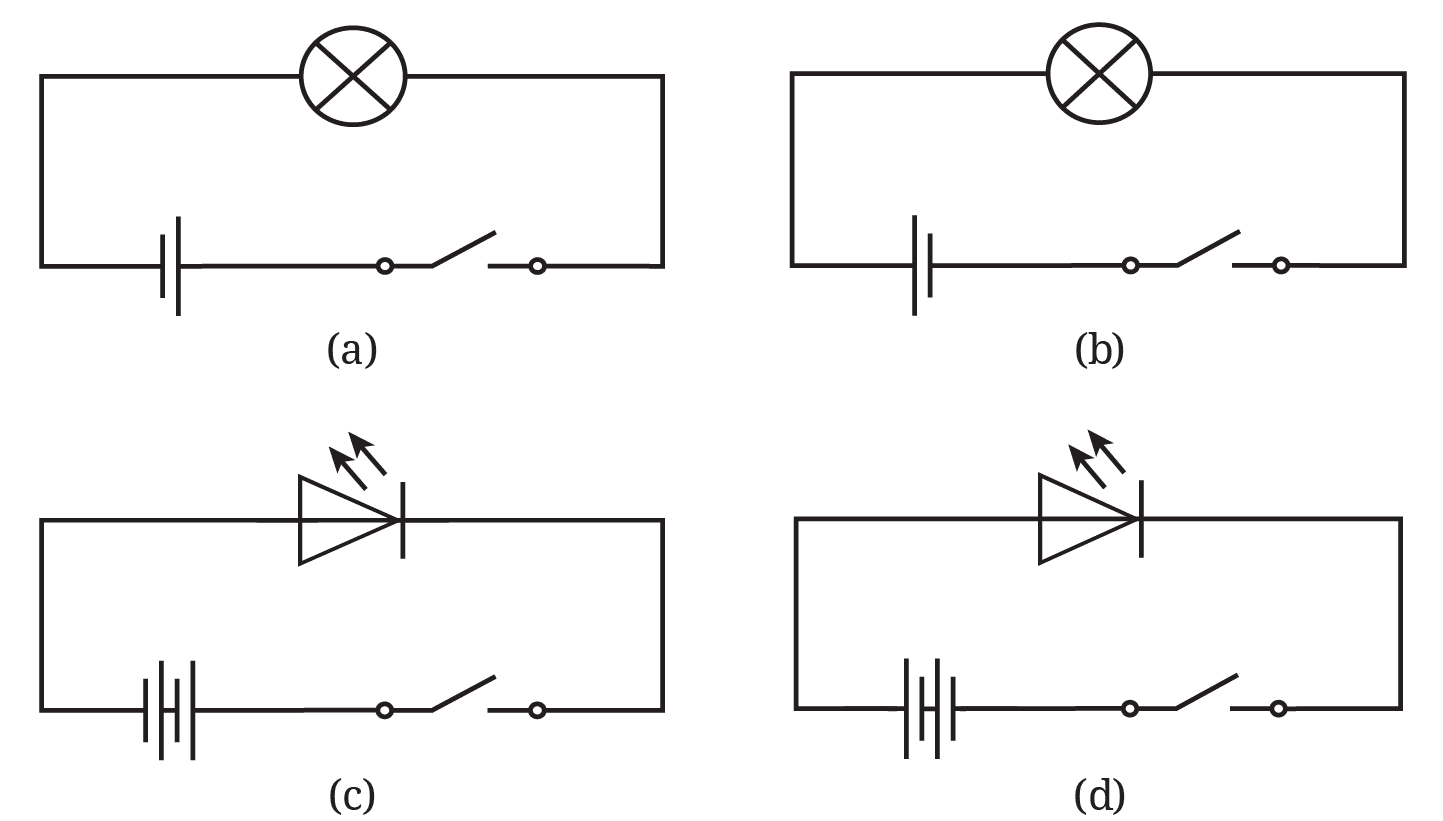
See AnswerThe lamp will not glow if the circuit is incomplete, the cell is connected incorrectly, the lamp is connected incorrectly or there is a short circuit. Analyzing the likely configurations in Fig 3.20: (a) Appears to be a correct series circuit, so the lamp should glow. (b), (c), (d): These diagrams likely show incorrect connections. The lamp will not glow in cases where the circuit path is broken, terminals are short-circuited (current bypasses the lamp), or components are wrongly connected relative to polarity.
9. Suppose the ‘+’ and ‘-‘ symbols cannot be read on a battery. Suggest a method to identify the two terminals of this battery.
See AnswerUse a Light Emitting Diode (LED). An LED has a longer lead (positive) and a shorter lead (negative). Connect the battery terminals to the LED’s leads. An LED glows only when its longer lead is connected to the battery’s positive terminal and its shorter lead to the battery’s negative terminal. Observe which connection makes the LED glow to identify the positive terminal of the battery.
10. You are given six cells marked A, B, C, D, E, and F. Some of these are working and some are not. Design an activity to identify which of them are working. (i) List the items that you require. (ii) Write the procedure that you will follow. (iii) With the items, carry out the activity to identify the cells that are working.
See Answer(i) Items Required: A known working lamp (or LED), connecting wires with stripped ends, (optional but helpful: a cell holder and lamp holder).
(ii) Procedure:
1. Set up a simple test circuit using the lamp and wires (and holders, if available), leaving a way to insert one cell at a time.
2. Insert cell A into the circuit.
3. Observe if the lamp glows. Record the result (Working/Not Working).
4. Remove cell A and repeat steps 2-3 for cells B, C, D, E and F individually.
(iii) (Activity execution requires physical items).
11. An LED requires two cells in series to glow. Tanya made the circuit as shown in Fig. 3.21. Will the lamp glow? If not, draw the wires for correct connections.

See AnswerLikely No. Fig 3.21 probably shows an incorrect series connection (e.g., positive connected to positive, or negative to negative). For cells to work correctly in series, the positive terminal of one cell must connect to the negative terminal of the next cell.
Correction: Ensure cells are connected positive-to-negative in series. Connect the overall positive terminal of the resulting battery (the free positive end of the first cell) to the LED’s longer lead (positive). Connect the overall negative terminal of the battery (the free negative end of the second cell) to the LED’s shorter lead (negative). (A drawing would show this correct wiring).
Class 7 Science Curiosity Chapter 3 Very Short Answer Type Questions
What is the function of a switch in an electric circuit?
See AnswerA switch either completes or breaks an electric circuit. It allows or stops the flow of current.
What does an electric cell provide to a circuit?
See AnswerAn electric cell provides electrical energy to the circuit.
Name the two terminals of a cell.
See AnswerPositive terminal and negative terminal.
Why does an LED glow only in one direction?
See AnswerBecause electric current can pass through it in only one direction—from positive to negative terminal.
What is a filament in an incandescent lamp?
See AnswerA thin wire inside the bulb that gets hot and glows when electric current passes through it.
Class 7 Science Curiosity Chapter 3 Short Answer Type Questions
Why is it important to connect electric cells in a particular order in a torch?
See AnswerCells should be connected in series (positive to negative terminals) to form a battery. This ensures proper current flow and makes the torch lamp glow.
What happens when the filament of an incandescent lamp breaks?
See AnswerThe lamp is said to be fused. The current cannot pass through the broken filament, so the lamp does not glow.
What do we mean by an electrical circuit?
See AnswerAn electrical circuit is a complete path that allows electric current to flow from the positive terminal of the cell to the negative terminal through a device like a lamp.
Why are wires covered with plastic or rubber?
See AnswerPlastic and rubber are insulators. They prevent electric shocks by stopping current from escaping the wire.
How can you identify the terminals of a battery if the symbols are not visible?
See AnswerObserve the cell holder—its connections indicate the positive and negative terminals. Positive is connected to the metal cap side of one cell; negative to the flat base of the other.
Class 7 Science Curiosity Chapter 3 Descriptive Answer Type Questions
Why do LEDs need to be connected correctly in a circuit?
See AnswerLEDs allow current to flow in only one direction. The longer wire (positive terminal) must be connected to the battery’s positive terminal, and the shorter wire (negative terminal) to the battery’s negative terminal. Reversing the connection will not allow the LED to glow.
Explain the difference between conductors and insulators with examples.
See AnswerConductors allow electric current to pass through them easily, e.g., copper, Aluminium. Insulators do not allow current to pass through, e.g., rubber, glass. Conductors are used for wires, while insulators are used to cover them for safety.
Why is copper commonly used for making wires and not gold or silver?
See AnswerThough silver and gold are better conductors, copper is widely used because it is less expensive and available in abundance.
What is a circuit diagram and why is it used?
See AnswerA circuit diagram is a symbolic representation of an electric circuit. It uses standard symbols for components to simplify understanding and communication of electrical setups.
How does a homemade switch work in a circuit?
See AnswerA safety pin touches two drawing pins fixed on cardboard. When it touches both, the circuit is complete and current flows. When it doesn’t, the circuit is broken and current stops.
Class 7 Science Curiosity Chapter 3 Exploring Questions
Why is it dangerous to use damaged wires or switches?
See AnswerDamaged wires or switches can expose conducting material. Since our body is a conductor, touching them may lead to electric shock, injury, or even death. Hence, they must be replaced immediately.
How would you test whether a cell is working or not using a simple circuit?
See AnswerConnect the cell in a circuit with a working lamp and wires. If the lamp glows, the cell is working. If it doesn’t, the cell may be dead or the connections may be faulty.
If electricity is unavailable in your home for two days, list five daily tasks that would be affected.
See AnswerTasks affected include:
Lighting the house
Using a refrigerator
Charging mobile phones
Watching TV or using the internet
Operating a water pump
Why do LEDs last longer and are more efficient than incandescent lamps?
See AnswerLEDs do not have filaments that burn out. They consume less power and convert more energy to light rather than heat, making them efficient and long-lasting.
Design an activity using a conduction tester to test if a material is a conductor or insulator.
See AnswerCreate a simple circuit with a cell and a lamp, leaving two wire ends free. Touch both ends to an object. If the lamp glows, it’s a conductor. If not, it’s an insulator. Test various objects like keys, plastic, wood, metal spoons, etc.
Let Us Discuss about Class 7 Science Curiosity Chapter 3
How does Class 7 Science Curiosity Chapter 3 explains about the glow of a torchlight only when the switch is turned ON in?
In Class 7 Science Curiosity Chapter 3, it is explained that a torchlight glows only when the switch is in the ON position because that is when the electrical circuit becomes complete. A complete or closed circuit allows electric current to flow from the positive terminal of the battery, through the wires, into the lamp (bulb) and then back to the negative terminal of the battery. The switch acts like a gate – when it is OFF, there is a break in the path, and current cannot flow. The bulb does not glow because there is no continuous path for the current. When the switch is turned ON, it bridges the gap and allows current to flow, lighting up the bulb. This concept of open and closed circuits is central to understanding how electric devices work, and Class 7 Science Curiosity Chapter 3 uses a torchlight as a simple example to demonstrate this principle.
Why can’t we use materials like plastic or wood instead of metal wires in circuits according to Class 7 Science Curiosity Chapter 3?
According to Class 7 Science Curiosity Chapter 3, materials like plastic or wood cannot be used as wires in electric circuits because they are insulators. Insulators are materials that do not allow electric current to pass through them. The chapter explains that for a circuit to work, the components need to be connected with conductors – materials that allow current to flow easily. Metals like copper and aluminium are excellent conductors and are used to make wires. On the other hand, plastic, rubber, wood and glass resist the flow of electricity and are used to cover wires and plugs for safety, not for conducting current. Using insulators in place of wires would break the circuit, preventing the flow of electricity and stopping the device from working. Through an activity called a conduction tester, Class 7 Science Curiosity Chapter 3 helps students test which materials conduct electricity and which do not, reinforcing this concept with real-world examples.
What happens if an LED is connected incorrectly in a circuit, as explained in Class 7 Science Curiosity Chapter 3?
In Class 7 Science Curiosity Chapter 3, it is clearly mentioned that an LED (Light Emitting Diode) must be connected correctly to work. LEDs are different from regular bulbs because they allow current to flow only in one direction. Each LED has two terminals: the longer wire is the positive terminal and the shorter wire is the negative terminal. If you connect the LED so that the positive terminal of the battery is joined to the shorter wire (negative terminal of the LED), the LED will not glow because current cannot flow through it in that direction. The LED only glows when the positive terminal of the battery is connected to the longer leg of the LED and the negative to the shorter leg. This concept helps us understand that some electrical components have polarity, meaning they must be connected the right way to function. The chapter uses practical activities and illustrations to show how direction matters in LED circuits, making it easier for students to grasp this concept.
The most important topic in Class 7 Science Curiosity Chapter 3 is understanding the electric circuit—how it works and how components like cells, wires, bulbs, switches and LEDs function together. Knowing how to draw and identify circuit diagrams, understanding the concept of open and closed circuits and the properties of conductors and insulators are also useful. These concepts form the foundation for understanding electricity in higher classes and practical life applications.
Is Class 7 Science Curiosity Chapter 3 easy?
Yes, Class 7 Science Curiosity Chapter 3 is considered easy if you focus on basic concepts and try out the simple activities given in the textbook. The chapter explains electricity through practical examples like torches, bulbs, and homemade switches, which make learning interesting and relatable. With regular revision and hands-on practice with circuits or circuit diagrams, most students find this chapter both fun and understandable.
How can we make Class 7 Science Curiosity Chapter 3 study easy?
To make Class 7 Science Curiosity Chapter 3 easy, students should:
- Draw and label circuit diagrams to understand connections.
- Perform simple experiments with batteries, bulbs and wires at home (under supervision).
- Use flashcards or charts to remember terms like conductor, insulator, LED, filament, etc.
- Watch animated videos or do model-based learning to visualize how current flows.
- Practice questions regularly from the NCERT textbook and sample papers.
- Understanding real-life applications of switches and circuits also helps retain the concepts longer.

